Abstract
A technique for increasing the ranging depth in optical frequency domain imaging utilizing frequency encoding is presented. Ranging depth is enhanced by using two interferometer reference arms with different path lengths and independent modulation frequencies (25 and 50 MHz). With this configuration, the sensitivity decreases by 6 dB over a depth range of 7 mm, approximately a threefold improvement over the conventional optical frequency domain imaging technique. We demonstrate that the reference arm frequency separation, tuning speed, center wavelength, and instantaneous coherence length determine the signal-to-cross-talk ratio.
The recent application of Fourier domain methods [1,2] to optical coherence tomography has resulted in significant improvements in detection sensitivity and imaging speed [3–6]. This result is clinically significant, since it permits comprehensive volumetric imaging of large tissue areas and potentially enables effective screening and surveillance for disease [7]. In many clinical applications, however, especially those for which catheter and endoscope probes are required for accessing internal organs, the separation between the probe and the tissue surface cannot be accurately controlled and an enhanced ranging depth is highly desirable. In optical frequency domain imaging (OFDI) [6], high sensitivity and imaging speed are achieved by replacing the broadband light source and delay-scanning of a time domain optical coherence tomography with a wavelength-swept laser and static interferometer reference arm. In this method, the instantaneous linewidth of the laser source, which is inversely proportional to the instantaneous coherence length, can limit the effective depth range over which high sensitivity can be achieved. Additionally, since electrical receivers cannot distinguish between positive and negative frequencies, frequency domain ranging suffers from a depth degeneracy that typically limits the ranging depth to one half of the coherence length. Although recent results have demonstrated wavelength-swept lasers with unprecedented speed and narrow linewidths [8,9], there remains a need for improved ranging depth in OFDI. Two general methods have been proposed to avoid the ambiguity between positive and negative depths and increase ranging depth: (1) measuring quadrature interference signals [10–12], and (2) using an acousto-optic modulator to shift the entire signal frequency band to positive frequencies [13].
In this Letter, a technique for increasing the ranging depth using frequency encoding in OFDI is presented. This technique uses two independent interferometer reference arms, each having an acousto-optic frequency shifter operating at a distinct frequency and an independent round-trip delay. We demonstrate with theory and experiment that the cross talk between the resulting two independent depth sections is determined by the frequency spacing, instantaneous coherence length, tuning range, center wavelength, and scanning frequency of the laser source. The experimental results indicate that an OFDI system with a sweep repetition rate of 12.5 kHz, tuning range of 117 nm, and instantaneous coherence length of 5 mm at 1300 nm can achieve a 7 mm ranging depth and minimum signal-to-cross-talk ratio (SCR) > 100 dB by using two acousto-optic frequency shifters operating at 25 and 50 MHz.
Figure 1 depicts a generalized schematic of an OFDI system comprising a wavelength-swept laser, an interferometer employing two optical frequency shifters in separate reference arms, a photoreceiver, and a signal processor. Interferometric fringes are registered by the detector, centered at two separate carrier frequencies, which correspond to the modulation frequency of the acousto-optic shifters. Fringe visibility is maximized at the zero path difference point for each frequency channel and decays in accordance with the instantaneous coherence length of the source as the path difference increases. The instantaneous coherence length Lc indicates the depth around the zero path difference point where the visibility drops to 0.5 and thereby the detection sensitivity drops by 6 dB. It is important to emphasize that the location in the sample path corresponding to the zero delay point for the two frequency channels (labeled B and D in Fig. 1) is determined exclusively by the respective reference arm delay setting and is independent of the carrier frequencies (labeled f1 and f2). The carrier frequencies can therefore be chosen to fully separate the wings of the signal bands. While this technique could, in principle, quadruple the −6 dB ranging depth of a conventional OFDI system with balanced detection by utilizing two sides of two coherence functions, three factors can degrade the image quality and the ranging depth improvement, including (1) cross talk between the two encoded images at different frequencies, (2) cross talk between a specific depth that corresponds to a frequency and the beat term frequency between two reference arms' electric fields, and (3) degradation of the system sensitivity due to shot noise power increase.
Fig. 1.
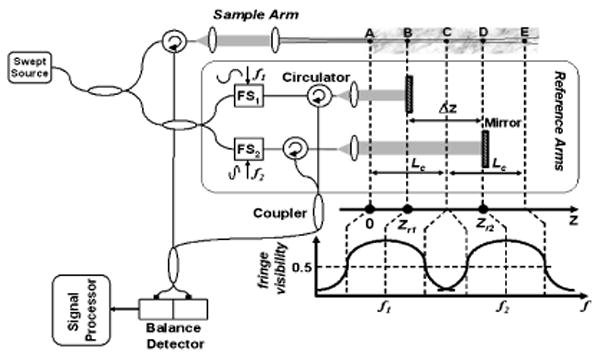
Schematic of the depth and frequency-encoding technique. FS, acousto-optic frequency shifter.
Cross talk can arise between the two frequency-encoded images when the coherence function tails of the two frequency bands interfere with each other as schematically represented in Fig. 2(a). To define the SCR and show SCR variation as a function of the frequency spacing (Δf), instantaneous coherence length, tuning range, center wavelength, and scanning frequency of the laser source, we derived the minimum SCR at the ith depth section using an OFDI system with N frequency shifts as
Fig. 2.
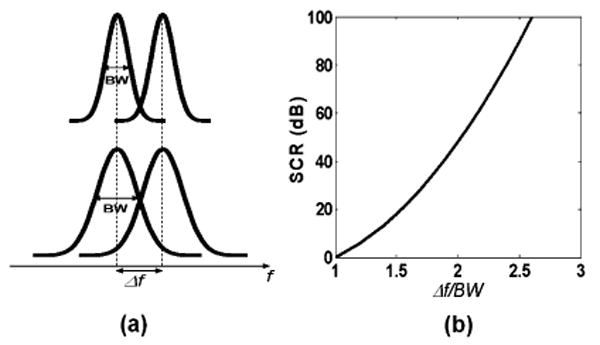
(a) Coherence function widening causes SCR degradation. (b) Minimum SCR as a function of frequency spacing to 6 dB coherence function bandwidth ratio.
| (1) |
| (2) |
| (3) |
where Si(f), ΣSi(f), Δλ, λ0, fa, and BW are the desired frequency-encoded signal, the undesired signal at the same frequency band, the source tuning range, the center wavelength, the scanning frequency of the laser source, and the 6 dB coherence function bandwidth.
As indicated by Fig. 2(a) and Eqs. (1)–(3), when the instantaneous coherence length, tuning range, inverse of the center wavelength, and scanning frequency of the laser source independently increase, the frequency content (BW) of each section encoded at a distinct frequency broadens as a result of the coherence function widening in the frequency domain. This frequency broadening results in SCR degradation due to interference between frequency bands. Figure 2(b) shows the theoretical minimum SCR derived in Eq. (1) as a function of frequency spacing (Δf=f2−f1) to 6 dB coherence function bandwidth (BW) ratio for two frequency shifts (N=2). This relationship was used to guide the choice of carrier frequencies in the experimental system.
Figure 3 depicts the experimental setup of an OFDI system employing two acousto-optic frequency shifters (25 and 50 MHz). A wavelength-swept laser was constructed to provide a tuning range of 117 nm from 1240 to 1357 nm and instantaneous coherence length of 5 mm. The laser was operated at rate of 12.5 kHz, and the balanced detectors had bandwidths of ∼80 MHz. The frequency-spacing-to-bandwidth ratio was ∼2.9 (SCR> 100 dB). The probe, comprising a galvanometer mirror and an imaging lens, produced a 40 μm 1/e2 diameter focal spot on the sample with a confocal parameter of 1.9 mm. The interferometer reference arm included a common reflector to adjust overall delay and a section wherein reference light was separated into two separate channels for independent frequency modulation (25 and 50 MHz) and differential delay. The path difference between the two channels was set to 10 mm (ΔL=2Lc) as shown in Fig. 3.
Fig. 3.
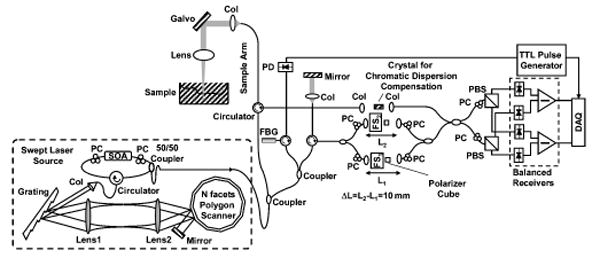
Experimental setup of the OFDI system. Col, collimator; PC, polarization controller; SOA, semiconductor optical amplifier; FBG, fiber Bragg grating; PD, photodetector; FS, acousto-optic frequency shifter; PBS, polarization beam splitter; DAQ, data acquisition board.
To evaluate the ranging depth enhancement using the frequency encoding method, we compared the sensitivity of the proposed method with the conventional OFDI system without a frequency shifter. For a shot-noise-limited OFDI system with N frequency shifters, the peak sensitivity decreases by the factor of N and ranging depth improves by the factor of 2N[1+10(PdB)-1 log10N]1/2 at the PdB sensitivity dropoff point, and thereby the −6 dB ranging depth improves by the factor of 2.82 when two frequency shifters are used. To experimentally characterize the ranging depth of the system, the point spread function was measured by using a calibrated partial reflector at various depths in the sample arm. The acquired sampled data at each depth was processed with the mapping algorithm described by Yun et al. [13]. Figure 4 shows the measured sensitivity as a function of depth for two system configurations: the first configuration utilized a single 25 MHz frequency shifter in a single reference arm; the second utilized two frequency shifters (25 and 50 MHz) in two reference arms according to the diagram of Fig. 3. We note that, in the latter configuration, the separation between the two sensitivity peaks can be arbitrarily set by adjustment of the relative lengths of the two reference arms. The penalty of −3 dB in peak sensitivity when using two frequency shifters is evident in Fig. 4. The benefit from the use of two frequency shifters, however, is also demonstrated: the total range over which the sensitivity remains within −6 dB of the peak is increased from 5 to 7 mm. The measured improvement for the case of two frequency shifters relative to the conventional approach without depthrange enhancement was therefore 2.8, in good agreement with the theoretical expectation. The measured axial resolution, defined as the FWHM of the point spread function, was 8 μm (in air) over the entire depth range.
Fig. 4.
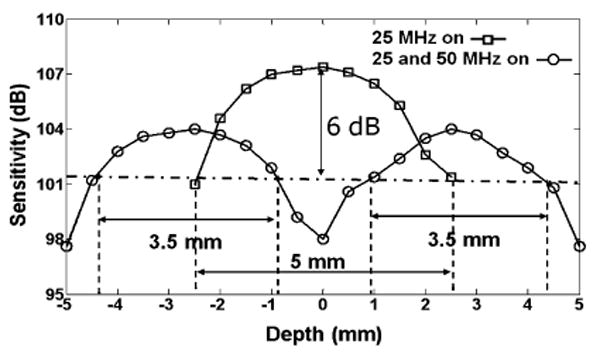
Measured system sensitivity, defined as the maximum attenuation producing a signal power equal to the noise power, for a configuration using one frequency shifter (squares, solid curve) and another using two frequency shifters (circles, solid curve).
An image of a human aorta was acquired ex vivo at the scanning frequency of 12.5 kHz with the depth and frequency-encoded OFDI system. This image was reconstructed by using the mapping algorithm described in [13]. The surface of the tissue was placed at an angle with respect to the probe beam axis, and the path difference between the two reference arms was set to 10 mm (corresponding to a 5 mm depth offset at the sample). The sample lens was configured to focus the light at the vertical center of the image. Figure 5(a) depicts an image of the aorta acquired with the use of a single frequency shifter at 25 MHz for resolving positive and negative depth ambiguity. Figure 5(b) depicts the same image using both frequency shifters. The upper and lower portions of the image were encoded at 25 and 50 MHz frequencies, respectively. The ranging depth was increased by a factor of compared with the single frequency shifter case.
Fig. 5.
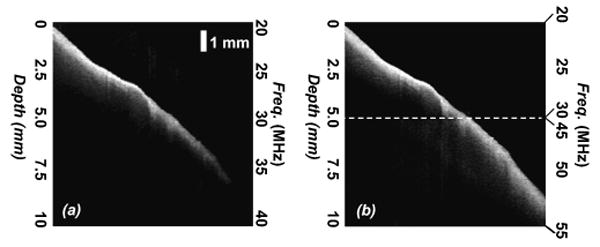
OFDI image of human aorta tissue ex vivo obtained with (a) frequency shift 25 MHz and (b) frequency shifts 25 and 50 MHz. Images consist of 1264 vertical × 500 transverse pixels and extend over a transverse distance of 9.0 mm. The depth and frequency-encoding technique increased the −6 dB ranging depth to 7 mm.
In summary, we have demonstrated a technique to increase the ranging depth in OFDI by using frequency encoding. This approach provides an approximately threefold increase in effective −6 dB ranging depth compared with conventional OFDI, with the penalty of a 3 dB loss in peak sensitivity. We investigated the effects of tuning speed and frequency spacing on the cross talk between the two frequency-encoded signal bands and found that SCR increases when the frequency spacing increases. Images obtained with the depth and frequency-encoded technique demonstrate the expected increase in ranging depth afforded by this new method.
Acknowledgments
This research was supported in part by the National Institutes of Health (contract R01 CA103769) and by the Terumo Corporation.
References
- 1.Kingsley S, Davies D. Electron Lett. 1985;21:434. [Google Scholar]
- 2.Fercher A, Hitzenberger C, Kamp G, El-Zaiat S. Opt Commun. 1995;117:43. [Google Scholar]
- 3.Leitgeb R, Hitzenberger C, Fercher A. Opt Express. 2003;11:889. doi: 10.1364/oe.11.000889. [DOI] [PubMed] [Google Scholar]
- 4.de Boer J, Cense B, Park B, Pierce M, Tearney G, Bouma B. Opt Lett. 2003;28:2067–2069. doi: 10.1364/ol.28.002067. [DOI] [PubMed] [Google Scholar]
- 5.Choma M, Sarunic M, Yang C, Izatt J. Opt Express. 2003;11:2183. doi: 10.1364/oe.11.002183. [DOI] [PubMed] [Google Scholar]
- 6.Yun S, Tearney G, de Boer J, Iftimia N, Bouma B. Opt Express. 2003;11:2953. doi: 10.1364/oe.11.002953. [DOI] [PMC free article] [PubMed] [Google Scholar]
- 7.Yun S, Tearney G, Vakoc B, Shishkov M, Oh W, Desjardins A, Suter M, Chan R, Evans J, Jang I, Nishioka N, de Boer J, Bouma B. Nat Med. 2006;12:1429. doi: 10.1038/nm1450. [DOI] [PMC free article] [PubMed] [Google Scholar]
- 8.Oh W, Yun S, Tearney G, Bouma B. Opt Lett. 2005;30:3159. doi: 10.1364/ol.30.003159. [DOI] [PMC free article] [PubMed] [Google Scholar]
- 9.Huber R, Wojtkowski M, Fujimoto J. Opt Express. 2006;14:3225. doi: 10.1364/oe.14.003225. [DOI] [PubMed] [Google Scholar]
- 10.Wojtkowski M, Kowalczyk A, Leitgeb R, Fercher A. Opt Lett. 2002;27:1415. doi: 10.1364/ol.27.001415. [DOI] [PubMed] [Google Scholar]
- 11.Vakoc B, Yun S, Tearney G, Bouma B. Opt Lett. 2006;31:362. doi: 10.1364/ol.31.000362. [DOI] [PMC free article] [PubMed] [Google Scholar]
- 12.Choma M, Yang C, Izatt J. Opt Lett. 2003;28:2162. doi: 10.1364/ol.28.002162. [DOI] [PubMed] [Google Scholar]
- 13.Yun S, Tearney G, de Boer J, Bouma B. Opt Express. 2004;12:4822. doi: 10.1364/opex.12.004822. [DOI] [PMC free article] [PubMed] [Google Scholar]


